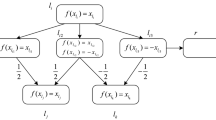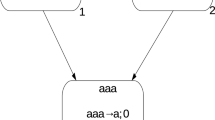Abstract
Spiking neural P systems are a class of distributed and parallel computing models inspired by spiking neurons. In this work, the features of neuron division and neuron budding are introduced into the framework of spiking neural P systems, which are processes inspired by neural stem cell division. With neuron division and neuron budding, a spiking neural P system can generate exponential work space in polynomial time as the case for P systems with active membranes. In this way, spiking neural P systems can efficiently solve computationally hard problems by means of a space-time tradeoff, which is illustrated with an efficient solution to SAT problem.
Similar content being viewed by others
References
Ionescu M, Păun Gh, Yokomori T. Spiking neural P systems. Fund Inform, 2006, 71: 279–308
Păun Gh. Membrane Computing, An Introduction. Berlin: Springer-Verlag, 2002
Chen H, Ionescu M, Ishdorj T O, et al. Spiking neural P systems with extended rules: universality and languages. Nat Comput, 2008, 7: 147–166
Chen H, Freund R, Ionescu M, et al. On string languages generated by spiking neural P systems. Fund Inform, 2007, 75: 141–162
Păun A, Păun Gh. Small universal spiking neural P systems. BioSystems, 2007, 90: 48–60
Chen H, Ionescu M, Ishdorj T O. On the efficiency of spiking neural P systems. In: Proceedings of the 8th International Conference on Electronics, Information, and Communication. Ulan Bator 2006. 49–52
Ishdorj T O, Leporati A. Uniform solutions to SAT and 3-SAT by spiking neural P systems with pre-computed resources. Nat Comput, 2008, 7: 519–534
Leporati A, Gutiérrez-Naranjo M A. Solving Subset Sum by spiking neural P systems with pre-computed resources. Fund Inform, 2008, 87: 61–77
Leporati A, Zandron C, Ferretti C, et al. Solving numerical NP-complete problem with spiking neural P systems. In: 8th Workshop on Membrane Computing, LNCS Vol. 4860. Berlin: Springer-Verlag, 2007. 336–352
Ferretti C, Leporati A, Mauri G, et al. On the computational power of spiking neural P systems. Int J Unconvent Comput, 2009, 5: 459–473
Leporati A, Mauri G, Zandron C, et al. Uniform solutions to SAT and Subset Sum by spiking neural P systems. Nat Comput, 2009, 8: 681–702
Galli R, Gritti A, Bonfanti L, et al. Neural stem cells: an overview. Circ Res, 2003, 92: 598–608
The P systems Website: http://ppage.psystems.eu
Garey M R, Johnson D S. Computers and Intractability. A Guide to the Theory of NP-completeness. San Francisco: W H Freeman and Company, 1979
Author information
Authors and Affiliations
Corresponding author
Rights and permissions
About this article
Cite this article
Pan, L., Păun, G. & Pérez-Jiménez, M.J. Spiking neural P systems with neuron division and budding. Sci. China Inf. Sci. 54, 1596–1607 (2011). https://doi.org/10.1007/s11432-011-4303-y
Received:
Accepted:
Published:
Issue Date:
DOI: https://doi.org/10.1007/s11432-011-4303-y




